Gigabyte H77N-WiFi Review – First Look at Ivy Bridge with mITX
by Ian Cutress on November 6, 2012 12:00 PM EST- Posted in
- Motherboards
- Gigabyte
- H77
- mITX
Rightmark Audio Analyzer 6.2.5
In part due to reader requests, we are pleased to include Rightmark Audio Analyzer results in our benchmark suite. The premise behind Rightmark:AA is to test the input and output of the audio system to determine noise levels, range, harmonic distortion, stereo crosstalk and so forth. Rightmark:AA should indicate how well the sound system is built and isolated from electrical interference (either internally or externally). For this test we connect the Line Out to the Line In using a short six inch 3.5mm to 3.5mm high-quality jack, turn the OS volume to 100%, and run the Rightmark default test suite at 48 kHz, 96 kHz and 192 kHz. The results are given both numerical ratings and word ratings from ‘Very Poor’ to ‘Excellent’. We grade this test by assigning each of the word ratings a value from 1-6, and the final result is the sum of these ratings, and the score should end up between 8 and 48.
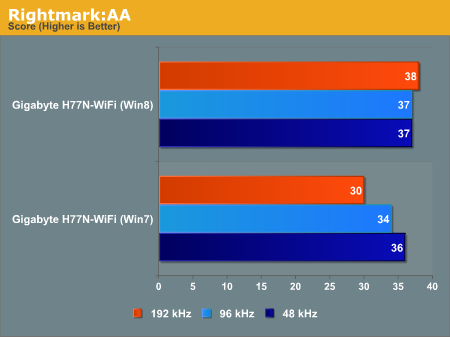
The Gigabyte board is our first motherboard on our test bed to go through Rightmark, so while we do not have any comparative numbers yet, but we can draw conclusions. In our testing, the Windows 7 performance rises with bit-rate, whereas the Windows 8 driver gives constant performance throughout. The dynamic range of the Realtek ALC892 is rated at 110 dBA ideal, but losses due to design come through – in this case the Gigabyte tops out at 86.2 dBA at 48 kHz.
USB Speed
For this benchmark, we run CrystalDiskMark to determine the ideal sequential read and write speeds for the USB port using our 240 GB OCZ Vertex3 SSD with a SATA 6 Gbps to USB 3.0 converter. Then we transfer a set size of files from the SSD to the USB drive using DiskBench, which monitors the time taken to transfer. The files transferred are a 1.52 GB set of 2867 files across 320 folders – 95% of these files are small typical website files, and the rest (90% of the size) are the videos used in the Sorenson Squeeze test.

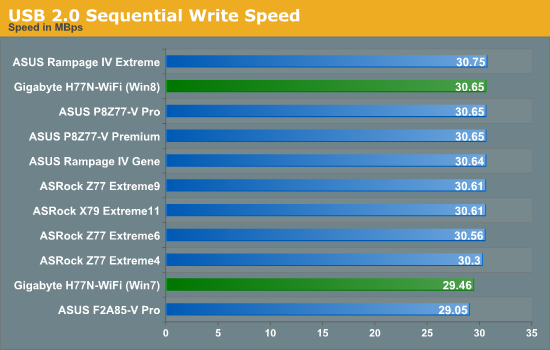
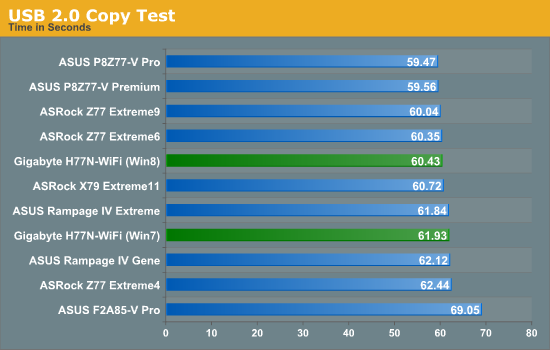

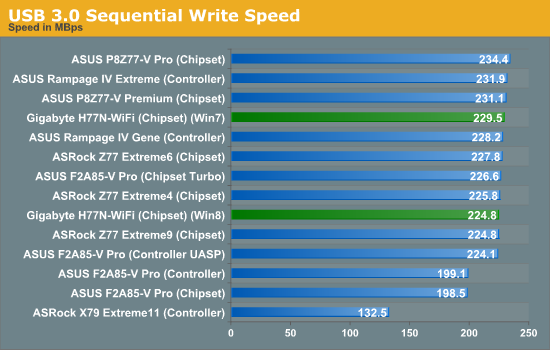

At some point in the future we will be adjusting our testing to Windows 8, which will be able to take advantage of the UASP protocol for USB 3.0 transfers. In our performance review of Windows 8 this manifested itself in an increase in sequential USB 3.0 read speed from 256.6 Mbps to 406.30 Mbps, which meant a 4% quicker USB copy test as writing was not similarly affected.
DPC Latency
Deferred Procedure Call latency is a way in which Windows handles interrupt servicing. In order to wait for a processor to acknowledge the request, the system will queue all interrupt requests by priority. Critical interrupts will be handled as soon as possible, whereas lesser priority requests, such as audio, will be further down the line. So if the audio device requires data, it will have to wait until the request is processed before the buffer is filled. If the device drivers of higher priority components in a system are poorly implemented, this can cause delays in request scheduling and process time, resulting in an empty audio buffer – this leads to characteristic audible pauses, pops and clicks. Having a bigger buffer and correctly implemented system drivers obviously helps in this regard. The DPC latency checker measures how much time is processing DPCs from driver invocation – the lower the value will result in better audio transfer at smaller buffer sizes. Results are measured in microseconds and taken as the peak latency while cycling through a series of short HD videos - under 500 microseconds usually gets the green light, but the lower the better.
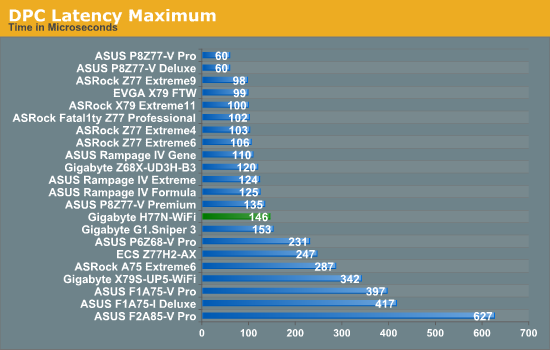
The DPC Latency test is starting to become one where we have two different types of motherboard manufacturer. The top tier manufacturers offer better software with their products, often with monitoring tools as part of the package in order to monitor overclocks or fan speeds. These monitoring tools inject high priority requests in the system on a regular basis (every 1-3 seconds), delaying other requests such as those for audio, causing spikes in DPC Latency which could lead to distortion or other audio anomalies. Surprisingly manufacturers without these tools do not have these issues. These issues are sometimes fixed via a BIOS update, but even if one board gets updated and fixed, it for some reason does not propagate to future products or the back catalogue. So here we are with the Gigabyte H77N-WiFi, which gives a good sub-200 microsecond result, but unfortunately while EasyTune6 is enabled, this can spike to 32000 microseconds. Ouch.










52 Comments
View All Comments
raavan19raavan - Monday, April 15, 2013 - link
The system runs fine when the display cable is connected to IGP but when it is connected to graphics card with the above settings, the display is just black with the LED blinking and switches from ANALOG to HDMI continuously without displaying anything. Disabled the IGP too and still doesn't work. Booted the system with the IGP and tried to see if the Device Manager shows something but it only shows IGP but doesn't display anything saying that a driver is missing or any new hardware has been detected.raavan19raavan - Monday, April 15, 2013 - link
Even exchanged the graphics card assuming it was DOA but it apparently wasn't and would work fine on other system except on this motherboard.